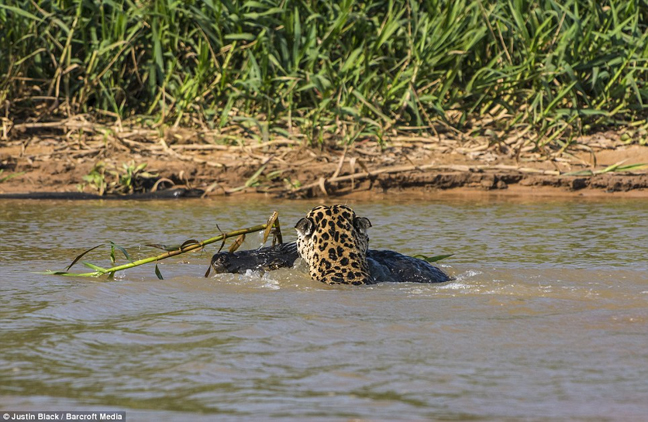Until this morning I had always assumed that a crocodile had no predators, sitting comfortably near the top of the food chain alongside the most evolutionarily perfect species on Earth — the great white shark. That assumption, however, was ripped to pieces minutes ago when I discovered a series of photographs shot by photographer Justin Black.
In his remarkable series of eight images, Black captured an incredibly rare moment on film when a jaguar emerged from the water around a small sand bank island in the Cuiaba River in the Pantanal Wetlands of western Brazil and launched a ferocious attack on a caiman basking in the sun. The 280-pound cat struck with lightning speed, gripping its powerful jaws onto the neck of the 8-foot-long, 150-pound reptile before whisking it away. In researching the topic I discovered that big cats such as jaguars and leopards often attack, kill, and eat adult caimans, crocodiles, and alligators. These cats are not alone in having an appetite for crocodilians — huge serpents such as anacondas and serpents also attack grown crocodilians when needed or desired. By contrast, alligators, caimans and crocodiles will eat just about any animal, fish or avian that they are large and strong enough to kill. The largest crocodilians will attack and eat animals that are as large as a bull.
When asked about witnessing the event, Black said: “[The jaguar] lifted the 150-pound caiman from the ground and trotted toward the water like it was a doggie bone. The fact he attacked from the water is astonishing. It was reminiscent of crocs attacking land animals in Africa.” The battle-scarred jaguar is very well known to biologists who have been studying the area, even nicknaming the fearless cat “Mick Jaguar”. The jaguar is estimated to be seven years old, and is almost blind in his right eye due to battles he has fought in the past.
I also came across a video showing a different jaguar-crocodile attack captured by a videographer, and apart from the impressive attack itself, watch how the jaguar manages to carry its prey up and over a river embankment. If you are as much of a lover of jaguars as I am, you will almost certainly be interested in 60 Minutes‘ fascinating report from August 2012 where they ventured into the sweltering jungles of South America to see if they could find one of the area’s incredibly rare jaguars. The story (which you can watch in full below as well) was inspired by the worldwide effort to help bring the jaguar back from the brink of extinction.
In 2013, it is believed that there are around 15,000 jaguars left in the world. It is estimated that around 18,000 jaguars were killed in the 1960s and 1970s for their fur. To learn how you can protect the jaguar from extinction, as well as the entirety of the world’s wildlife, be sure to visit the Wildlife Conservation Society at WCS.org.
SEE ALSO: New Video From Peru’s Amazon Of One Of World’s Last Uncontacted Tribes
SEE ALSO: Tourist Captures Insane Video Of Epic Cliff Collapse On Beach In Northern France
SEE ALSO: Archaeological Goldmine: Dramatic New Mayan Temple Covered In Giant Faces Discovered In Guatemala


